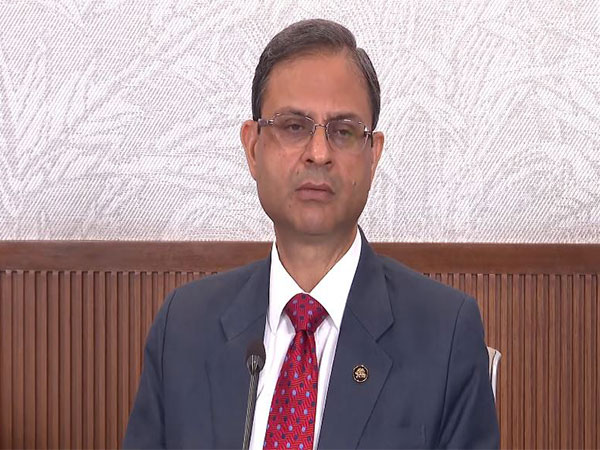Mumbai (Maharashtra) [India], April 27 (ANI): Policy continuity and stability, financial stability, fiscal prudence and efficiency, thrust on infrastructure, renewed focus on manufacturing, demographic dividend, innovation, continued focus on Ease of Doing Business and reforms, digitalisation are among factors that will push India’s growth trajectory over the medium to long-term, RBI Governor Sanjay Mahlhotra said.
He made these remarks during his keynote address at the US-India Economic Forum, organised by the Confederation of Indian Industry (CII) and the US-India Strategic Partnership Forum (USISPF), in Washington DC, earlier this week. The transcript of his address has been published on the RBI website on Sunday afternoon.
The RBI Governor touched upon India’s economic growth scenario in his initial remarks, before explaining the growth factors that he believes will further enhance India’s growth.
He said that the Indian economy has demonstrated remarkable resilience and dynamism.
Over the past four years (2021-22 to 2024-25), it has recorded an average annual growth rate of 8.2 per cent.
“It was and continues to be the fastest-growing major economy in the world,” the central bank chief. “This is a significant step up from the average growth rate of 6.6 per cent in the preceding decade (2010 to 2019).”
“Even this year, our growth is expected to remain robust at 6.5 per cent. This is despite the tremendous increase in uncertainty and volatility in global financial markets. While this rate is lower than in recent years and falls short of India’s aspirations, it remains broadly in line with past trends and the highest among major economies,” he supplemented.
Over the last ten years, India has leapfrogged from the tenth-largest economy to the fifth-largest. India is poised to become the third-largest economy shortly.
Citing research that shows political and policy stability is a prerequisite for long-term investment planning to fuel growth in any economy, the RBI Governor said India’s vibrant democracy has ensured the same over the decades.
“While the pace and specific focus of reforms may have varied from time to time, the commitment to a more market-oriented economic structure has not changed. In a phased manner, almost all sectors have been opened up to 100% foreign direct investment (FDI). Almost 90% of the FDI is now under the automatic route,” he supplemented.
Explaining India’s financial stability, he said the country’s financial sector is strong and vibrant, efficiently catering to the funding requirements of various economic agents.
“Financial stability is essential for businesses and people to make expenditure and investment decisions with confidence,” the central bank chief said.
The Indian capital markets – equity and debt – have increasingly deepened, providing avenues for market-based funding to businesses, he emphasised. India’s capital markets have witnessed record participation from retail and institutional investors, channelising savings into productive investments.
Elaborating on fiscal prudence and efficiency, he said India continues to demonstrate fiscal prudence to foster faster and inclusive growth.
“Its approach to the pandemic is a case in point. India adopted a calibrated approach to the pandemic. Rather than front-loading stimulus packages, as most countries did, India adopted a flexible and agile approach to support the vulnerable sections of society and small firms. This enabled a resilient recovery as it was followed up with enhanced capital expenditure and a concerted push to manufacturing,” the RBI Governor said.
On the manufacturing front, he stated that India is focused on achieving self-reliance in manufacturing.
“India’s manufacturing sector is gaining momentum and emerging as a potent sector for investment, with support from policy measures such as the Production-Linked Incentive (PLI),” he stressed.
Furthermore, when discussing digitalisation, he placed particular emphasis on UPI’s growth.
“The Reserve Bank is also promoting and nurturing digitalisation and innovation,” he said. “The Unified Payments Interface (UPI) is one such example. Processing about 18 billion transactions in a month, it is setting global benchmarks in seamless, secure, real-time systems. UPI has demonstrated how public digital infrastructure can empower private sector innovation for promoting financial inclusion.”
In conclusion, he stated that India continues to be an economy supported by stability – both monetary, financial, and political; policy consistency and certainty; a congenial business environment; and strong macroeconomic fundamentals.
At a time when many advanced economies are facing economic headwinds and a deteriorating economic outlook, India continues to offer strong growth and stability, making it a natural choice for investors seeking long-term value and opportunity, he added.
India’s strong domestic demand and relatively lower dependence on exports cushion the Indian economy from external spillovers, he opined.
“As the world’s fastest-growing major economy, India is not just a destination for investment – it is a partner in prosperity. Together, we have the chance to shape the future – not only for India but for a better world,” he concluded, inviting the business community to be a part of this journey, to collaborate, innovate, and invest in India. (ANI)
Disclaimer: This story is auto-generated from a syndicated feed of ANI; only the image & headline may have been reworked by News Services Division of World News Network Inc Ltd and Palghar News and Pune News and World News
HINDI, MARATHI, GUJARATI, TAMIL, TELUGU, BENGALI, KANNADA, ORIYA, PUNJABI, URDU, MALAYALAM
For more details and packages












